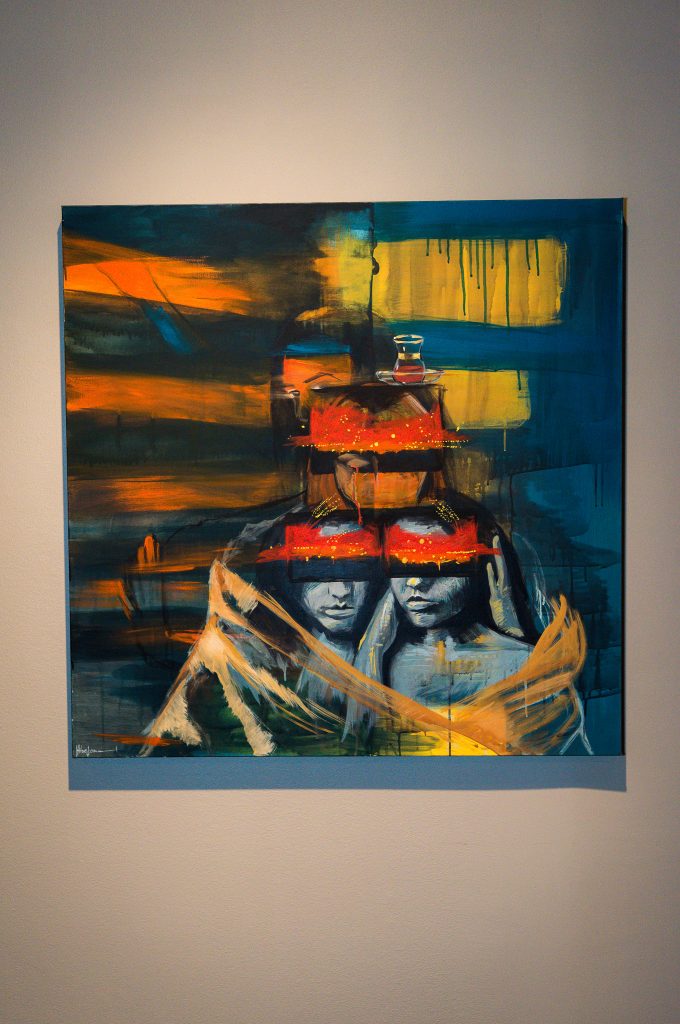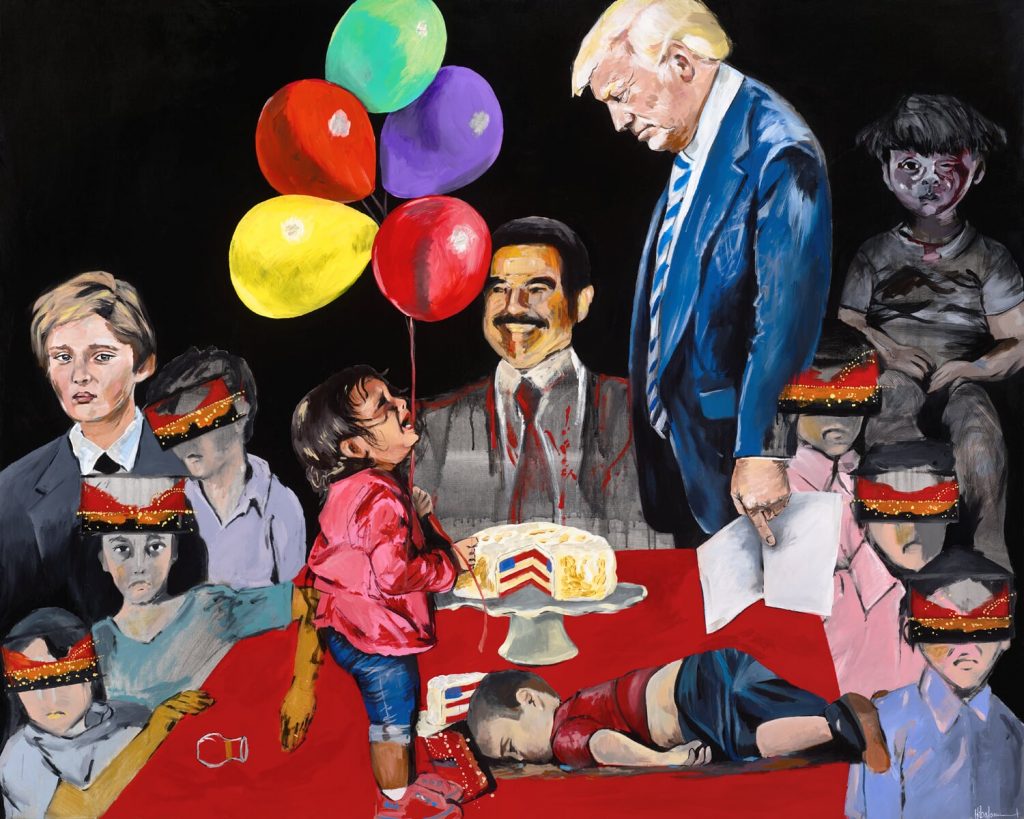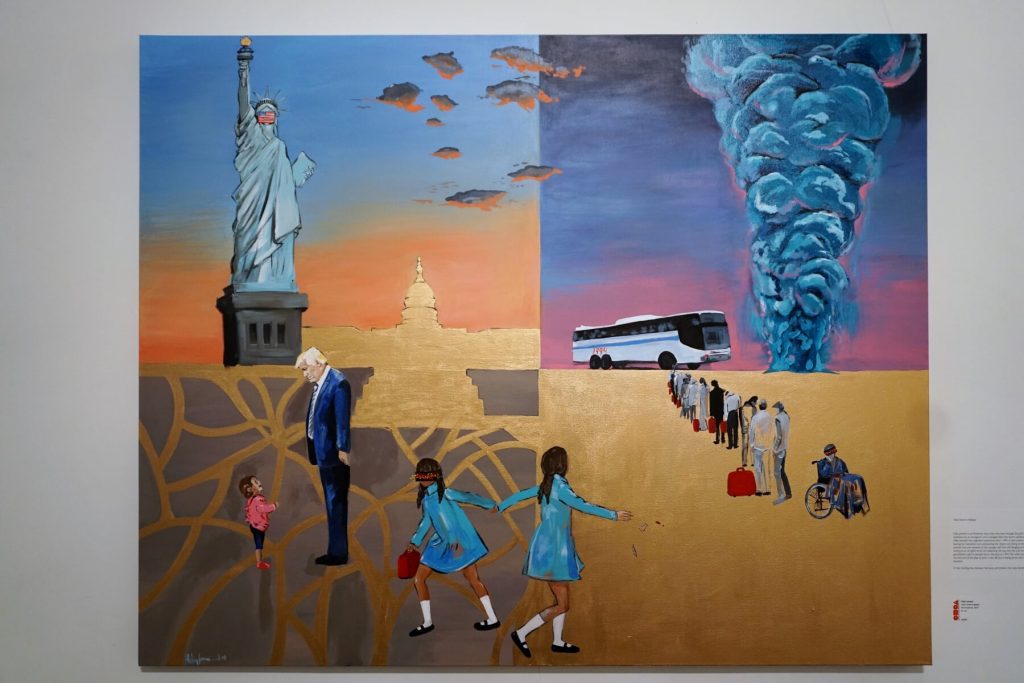An eight-year-old little girl sits wide eyed, frightened and unable to sleep as the echo of the bombs decimating nearby buildings reverberate into her very bones. She sits with her family in the corners of their home praying that, if a bomb were to fall, the corners would keep them safe and stay upright — a conclusion they came to after seeing many other buildings surrounding them destroyed — not the corners though. Across from the corner the little girl is huddled in with her family, is a window that lights up with the bright reds, oranges and yellows of war. Her mother looks at her with a smile and a glossy sadness in her eyes and tells her to imagine that the bright colors are the ones from the Atari game that she loves so much, and that everything would be alright.
This was Hiba Jameel’s reality as a child. Jameel lived in Baghdad, Iraq during the Gulf war and still recalls the details of enduring the dictatorship of Saddam Hussein and the death, destruction and war that proceeded. Out of wartime trauma birthed a beautiful coping mechanism, art.

At age eight she remembers making sculptures using shrapnel she found in the streets of Baghdad near her house. “During the day we would be playing outside. I didn’t know what these were they just had a distinct smell and an odd shape and I played with them. Of course, when my family would catch me they would tell me no,” Jameel explained. “It was something that I didn’t know I was doing at the time, to work through these issues. When I became an adult I came to understand myself. I had been doing this my whole life as a form of therapy.”
Once Jameel realized what a healthy tool art had been for her all these years she knew she wanted to help others deal with their own emotional distress as she had, through art. She began organizing interactive art events, called Psychosomatic, that use art therapy to talk about and address how to use art for healing. “I paint the pieces and participants help finish it,” Jameel tells us. “It is about the impact of mental illness to our physical health. I had them paint their psychosomatic life experience on one part of their body and I would usually guide them through it.” The goal of the project was to not only teach art but to address the very real physical impacts of mental illness and distress. “Getting a headache after an anxiety attack, or your stomach turning, or IBS symptoms flaring up. Things like that,” Jameel illustrated.

Mental illness is still a subject that is shrouded in a lack of understanding which perpetuates a negative stigma towards those who are open about it. Because of this, many people find it hard to admit to family, friends and even professionals about it, in order to seek help. Jameel acknowledges the difficulty of dealing with trauma and mental illness. “I made it a point in my career to address mental health and to include it in my art and to bring it to light and talk about it,” she explained. “As immigrants and people who come from very difficult backgrounds they [her parents] just kind of swallowed their pain and looked forward to the next day and dealt with it that way. It was never something that we addressed at home. I wish that my family had talked about it but that is something that I am changing in my daughter’s life.”
Jameel later discovered that she suffers from PTSD and has an anxiety disorder but through her art and other forms of therapy she has turned experiences that once gave her great pain into objects of great beauty. “I am happier than ever, I would say,” Jameel revealed.
Both Jameel and her work are dynamic and multifaceted. Her painting titled, “I REALLY DON’T CARE, DO U?” was an artistic response to the US zero-tolerance immigration policy. “I had already made the painting for my previous show in March which was about the Gulf War. The painting had the previous [Iraqi] President Saddam [Hussein] sitting at a table with children and they had screens on their face. Those screens are the window that I saw every night during the Gulf War. He was sitting at a table with a birthday cake. A bomb shelter was bombed so Baghdad smelled like BBQ for weeks because a lot of people were stuck inside and they were burned, so I put the famous picture of the bomb shelter that was bombed behind Saddam in that painting.” Jameel illustrated.

The original painting had so much depth and clearly depicted that the children were innocent victims during the Gulf War. Once the zero-tolerance immigration policy was making headlines Jameel was inspired to show the parallels between her experiences as a young girl and the actions of America’s current administration. “I was just innately reacting because I am an immigrant myself,” Jameel explained. Her reaction was to incorporate the Times Magazine image of Donald Trump looking down at the crying immigrant child into the painting, as well as the deeply painful image of the Syrian refugee child who washed ashore with his father. “These kids made the news and after that they were forgotten. I wanted to put them in the painting and continuously remind people of who they were. I wanted to depict them in my paintings and draw a parallel. We live in a world where children are the casualties.”
Jameel also added Barron Trump to the painting, behind the children at the table with windows over their eyes. “What if this was their child? That is why I put Barron Trump on there. How would he feel if it was his child?” Seeing Trump tear apart families who were in situations much like she was as a child shocker her. “I traveled with my family here and I couldn’t fathom the idea. What if at the border when I came to this place that was supposed to be a sanctuary, they took me away from my mom, my only security blanket? How would that feel and what if this was one of my children? At the time when I painted that she [Hiba’s daughter] was four and it tore me to pieces. I was really triggered by it. I felt for those people. I felt like it was a violation of any basic human rights,” Jameel continued.
When I asked her about her family’s decision to leave Iraq she responded, “It wasn’t so much a decision as it was the only way we could survive.” Jameel’s family faked passports in Jordan to get to Syria where her mother was able to obtain political asylum for the entire family there and with the United Nations. In 1998 United Nations brought Jameel and her family to the United States. “As an 11 year old girl it was pretty traumatic to know that you’re faking your identity, you’re crossing the border, you’re on the verge of being found out and God knows what would happen if you are found out. We were pushed to do that. It was a survival decision,” Jameel continued.

A survival decision made by the women in her family that wanted nothing more than a safe place for their children and grandchildren to grow up. “I have huge respect for my mother and my grandmother. When I look back I always wonder, ‘How did they do it?’ They took so much risk in their life,” Jameel reflects. “That courage that they had. The strength they had. I’m in awe of it. As a mom I am always reflecting back on what my mom and my grandmother had to endure. They took charge as Middle Eastern women who, by society’s rules, were supposed to be sheltered, but they were leaders in their circles and in their lives. They took care of the whole family, men and women, and all that with respect and dignity.” Jameel goes on to explain how her mother worked three jobs when they were in Syria so that her family had a decent living. “To sacrifice that much of your life for others and all with dignity and respect is so huge. Looking back at their experience gives me a push to be the best version of myself. I ask myself every night, ‘How can I be better tomorrow?’”
Jameel’s painting, “I REALLY DON’T CARE, DO U?” among many other incredible pieces will be showcased, December 8th at our upcoming event, RESIST. Be sure to be there because this may be your last chance to see the piece up close and personal before it is sent to the Newseum in WA, DC. All funds from RESIST will be donated to Northwest Immigrant Rights Project in Washington state to further their mission of, “defending and advancing the rights of immigrants through direct legal services, systemic advocacy, and community education” for those detained at the Detention Center in Tacoma, WA — which is the third largest immigration detention center in the country.
Follow Hiba Jameel on Instagram at HibaJArtStudio and buy into the raffle at December’s event for a chance to win one of Jameel’s prints!